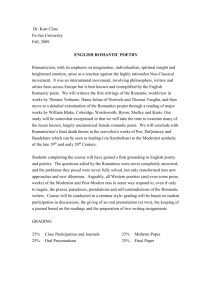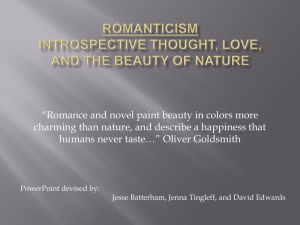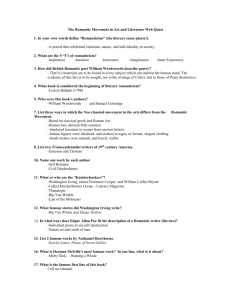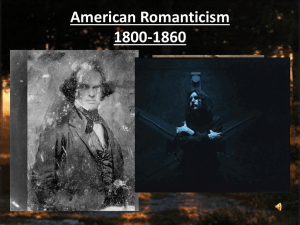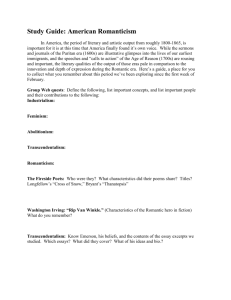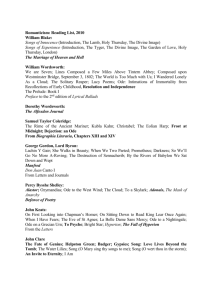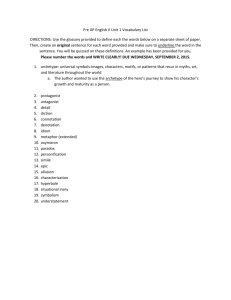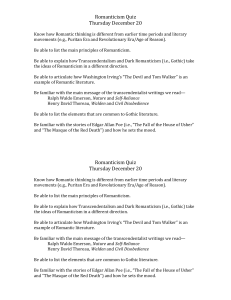File - ENGLISH WITH MS. FRIEDERICH
advertisement
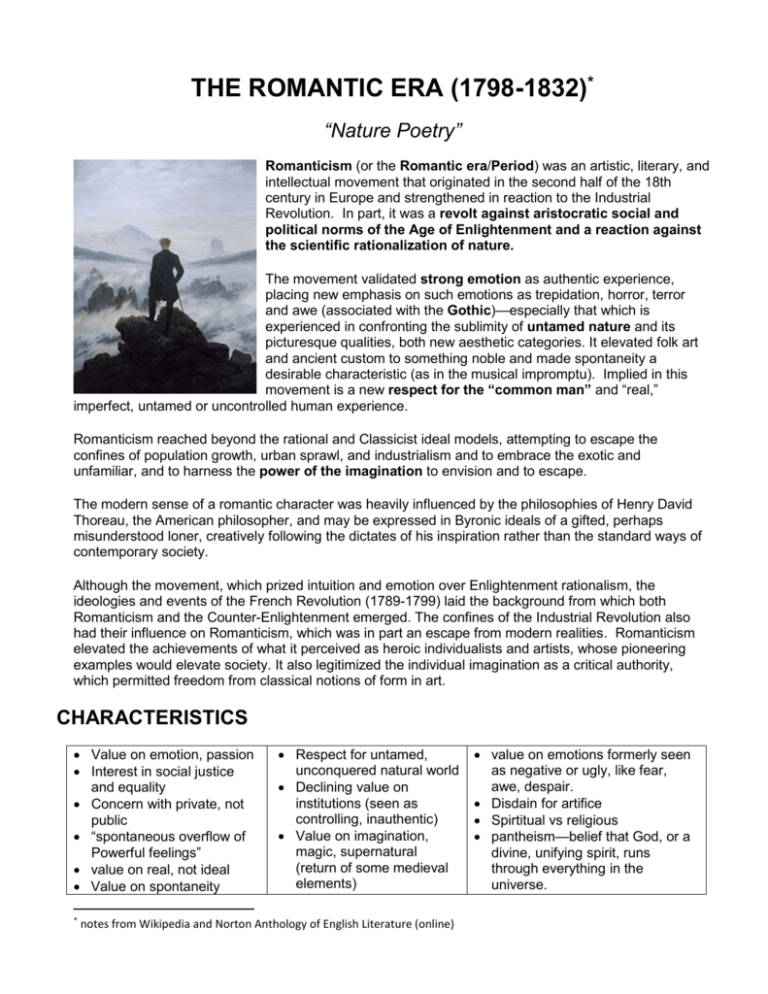
THE ROMANTIC ERA (1798-1832)* “Nature Poetry” Romanticism (or the Romantic era/Period) was an artistic, literary, and intellectual movement that originated in the second half of the 18th century in Europe and strengthened in reaction to the Industrial Revolution. In part, it was a revolt against aristocratic social and political norms of the Age of Enlightenment and a reaction against the scientific rationalization of nature. The movement validated strong emotion as authentic experience, placing new emphasis on such emotions as trepidation, horror, terror and awe (associated with the Gothic)—especially that which is experienced in confronting the sublimity of untamed nature and its picturesque qualities, both new aesthetic categories. It elevated folk art and ancient custom to something noble and made spontaneity a desirable characteristic (as in the musical impromptu). Implied in this movement is a new respect for the “common man” and “real,” imperfect, untamed or uncontrolled human experience. Romanticism reached beyond the rational and Classicist ideal models, attempting to escape the confines of population growth, urban sprawl, and industrialism and to embrace the exotic and unfamiliar, and to harness the power of the imagination to envision and to escape. The modern sense of a romantic character was heavily influenced by the philosophies of Henry David Thoreau, the American philosopher, and may be expressed in Byronic ideals of a gifted, perhaps misunderstood loner, creatively following the dictates of his inspiration rather than the standard ways of contemporary society. Although the movement, which prized intuition and emotion over Enlightenment rationalism, the ideologies and events of the French Revolution (1789-1799) laid the background from which both Romanticism and the Counter-Enlightenment emerged. The confines of the Industrial Revolution also had their influence on Romanticism, which was in part an escape from modern realities. Romanticism elevated the achievements of what it perceived as heroic individualists and artists, whose pioneering examples would elevate society. It also legitimized the individual imagination as a critical authority, which permitted freedom from classical notions of form in art. CHARACTERISTICS Value on emotion, passion Interest in social justice and equality Concern with private, not public “spontaneous overflow of Powerful feelings” value on real, not ideal Value on spontaneity * Respect for untamed, unconquered natural world Declining value on institutions (seen as controlling, inauthentic) Value on imagination, magic, supernatural (return of some medieval elements) notes from Wikipedia and Norton Anthology of English Literature (online) value on emotions formerly seen as negative or ugly, like fear, awe, despair. Disdain for artifice Spirtitual vs religious pantheism—belief that God, or a divine, unifying spirit, runs through everything in the universe. TERMS 1) 2) 3) 4) 5) Allusion Apostrophe Ballad Contrast Gothic 6) Inversion 7) Lyric (Wordsworth) 8) Ode 9) Romanticism 10) Sonnet (Keats, Wordsworth) 11) 12) 13) 14) Terza Rima (Shelley) Quatrain Spenserian stanza (Byron) Supernatural WORKS TITLE THEME/IDEAS My Heart Leaps Up (William Wordsworth 1770-1850) Beneficial influence of nature Power of human mind Appreciation of wandering/wanderers (the lonely artist) Splendor of childhood: “the child is the father of the man” Power of memory Power of sensory experience (vision/sight) Spirituality found in being “one” with nature Beneficial influence of nature Burdensome nature of worldliness, consumption Lack of harmony between modern society and nature (allusion here to the business and materialism of Industrial Revolution) The World is Too Much With Us (William Wordsworth 1770-1850) FORM lyric CONVENTIONS, DEVICES, CHARACTERISTICS paradox naiveté and awe of childhood is reminiscent of Blake’s “The Lamb lyric sonnet (Petrarchan) allusion pastoral mood meditative TITLE The Rime of the Ancient Mariner (Samuel Taylor Coleridge 1772-1834) Apostrophe to the Ocean (George Gordon, Lord Byron 1788-1824) THEME/IDEAS experiencing, respecting, and empathizing with nature are integral to the development of a complete soul and sense of personhood. Imagination, intellect, philosophy, poetry, piety are not at odds with one another, but are derived from nature and thus work together and are linked to God. The natural world, and all the beings in it, no matter how physically ugly or “below us” are part of us and our world. We are all interdependent. Mistreatment of the natural world will have dire consequences for humanity and the individual. Nature contains an innate, constant joyousness wholly separate from the ups and downs of human experience. It should NOT have human emotions attributed to it (don’t personify it; it is larger than we are) Glimpse of the Byronic/Romantic Hero seen: defiant, melancholic, free, but haunted by secret guilt Nature is awe-inspiring in its wildness, supremacy, power, and amorality. Humans do not control nature Humans wreak havoc upon the earth and only nature can control or overpower humans, making it Godlike. Time ravages all but the natural world. There is beauty in the terrible, the ugly. Nature is the “father” of humans; we are part of and from nature and thus, Nature is Godly. FORM Ballad Loose tetrameter Ode The Spenserian stanza, invented by Edmund Spenser. Each stanza has 9 lines: 8 in iambic pentameter, followed by 1 'Alexandrine' line in iambic hexameter. Rhyme scheme: ababbcbcc. CONVENTIONS, DEVICES, CHARACTERISTICS Symbolism: albatross, sleep, dreams/dreaming, sun, moon: the sun and the moon represent two sides of the Christian God: the sun represents the angry, wrathful God, whereas the moon represents the benevolent, repentant God. Christian Symbolism Intentionally archaic language and the epigraph combine to create a truly “Romantic” (reminiscent of medieval times) feel. Aphorism Didacticism Apostrophe Personification Allusion Metaphor Simile Repetition Parallelism Hyperbole Pantheism TITLE THEME/IDEAS FORM Ode to the West Wind pantheism—the belief that God, or a divine, unifying spirit, runs through everything in the universe. This force is the cause of all human joy, faith, goodness, and pleasure and can influence people to change the world for the better. It is also the source of poetic inspiration and divine truth. Shelley simultaneously recognizes that nature’s power is not wholly positive. Nature also destroys cruelly and indiscriminately. Delight in nature is mitigated by an awareness of its dark side. The divine in nature is the source of poetic inspiration. Death is inevitable; life is transient Life is paradoxical (“aching pleasure”) Beauty should be contemplated. Beauty can be overwhelming and even painful. speaker leaves the real world to explore a transcendent, mythical, or aesthetic realm. At the end of the poem, the speaker returns to his ordinary life transformed in some way and armed with a new understanding. Nature gives comfort, escape, relief from numbness incurred by existence in material, modern, industrialized world. The weight of the world causes need to escape through art, thought, emotion, drugs/alcohol, nature Escapism Freedom and relief/comfort in isolation Ode 5 stanzas in each part (4 tercets and a couplet) Iambic pentameter Terza rima ABA BCB CDC DED EE. Allusion Imagery Apostrophe Hyperbole Assonance Consonance Pantheism Autumn as a symbol and motif Ode 10 line stanzas ababcdecdcde Alliteration Allusion Apostrophe Imagery Hyperbole Pantheism Shakespearean Sonnet with solution in final couplet Quatrain Couplet Parallelism Hyperbole (Percy Bysshe Shelly 1792-1822) Ode to a Nightingale (John Keats 1795-1821) When I Have Fears that I May Cease to be (John Keats 1795-1821) CONVENTIONS, DEVICES, CHARACTERISTICS Achieving oneness with nature and God are impossible due to human and temporal limitations. Henry David Thoreau Henry David Thoreau (July 12, 1817 – May 6, 1862) was an American author, poet, philosopher, abolitionist, naturalist, tax resister, historian, and leading transcendentalist who was best known for his book Walden, a reflection upon simple living in natural surroundings, and his essay Civil Disobedience. In addition, his writings on natural and environmental history, ecology, and philosophy are sources of modern day environmentalism. Thoreau was deeply interested in the ideas of close observations, personal experience, and survival in the face of hostile elements, historical change, and natural decay. He advocated abandoning illusion, materialism and consumerism, in order to discover life's true essential needs. Thoreau was one of the original American nonconformists. He rejected materialism, lived modestly, often in near-poverty, and “did his own thing” despite social pressure and ostracism. Regarded as an eccentric failure in his lifetime, posterity sees him as a heroic philosopher who walked the walk rather than blithely talking the talk from a position of comfort and security. Thoreau's environmental philosophies and writings on civil disobedience and abolitionism have influenced the political thoughts and actions of such notable figures as Leo Tolstoy, Mohandas Gandhi, and Martin Luther King, Jr., and the Romantic poets, John Keats, Percy Shelley, and George Gordon (Lord Byron) Excerpt from Walden I went to the woods because I wished to live deliberately, to front only the essential facts of life, and see if I could not learn what it had to teach, and not, when I came to die, discover that I had not lived. I did not wish to live what was not life, living is so dear; nor did I wish to practice resignation, unless it was quite necessary. I wanted to live deep and suck out all the marrow of life, to live so sturdily and Spartan- like as to put to rout all that was not life, to cut a broad swath and shave close, to drive life into a corner, and reduce it to its lowest terms, and, if it proved to be mean, why then to get the whole and genuine meanness of it, and publish its meanness to the world; or if it were sublime, to know it by experience, and be able to give a true account of it in my next excursion. For most men, it appears to me, are in a strange uncertainty about it, whether it is of the devil or of God, and have somewhat hastily concluded that it is the chief end of man here to "glorify God and enjoy him forever."
